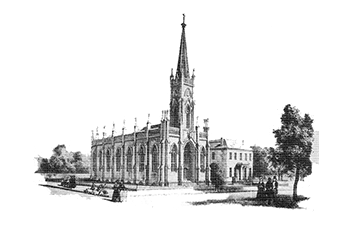The 19th Century Gothic Crucifix
Displayed in the Great Hall of the Father David O’Connor Family Life Center
Referred to as the Bishop John J. Chanche crucifix, it was discovered in the crypt of the basilica hanging high on the wall out of sight, heavily wrapped in plastic. It was “broken and bruised” with old, unprofessional repairs. During a tour for the St Mary Basilica Archive committee, Betsy Holleman was so moved to express that her family would like to have it restored. By coincidence the Conrad Schmidtt firm in Wisconsin, which had restored the interior of the basilica in 2001, was restoring the cathedral in Jackson and offered to take on the restoration, and the rest is history.
Because there are no known written records of the crucifix, it is believed to be from the first period of the diocese in Natchez much like the Immaculate Conception shrine in the Bishop’s Prayer Garden, however, it is identified in a late 19th century photograph of the cathedral interior tied on the pillar under the St. Alphonsus stature—the Redemptorist founder. Evidently it was brought out of storage for the lenten period. The top of the fleur-de-lis on the cross had a notch cut out to fit under the bracket holding the St. Alphonsus stature indicating that originally it had occupied another place in the cathedral. The crucifix is not rare, but considered valuable patrimony of the catholic church in Natchez. On May 3,1869 Bishop William Henry Elder made a rough note concerning a blessed iron nail “which is preserved in the Sacred Feet of the large crucifix…in the Cathedral…”
The corpus of the crucifix is made of solid plaster and is almost human in scale. The wood cross is about 7’ 3”. Historically, gothic crucifixes of this size are featured suspended in the sanctuary or on the wall of the apse. If it was in the sanctuary of the cathedral, it had a short usage from around 1843 and 1846 when it was replaced by a painting— the arrival of the Immaculate Conception painting from the King and Queen of France in 1846. This painting was requested by Bishop Chanche and he hung it on the wall of the apse in his cathedral. The painting was removed to the Episcopal Residence when the first fresco of the crucifixion was painted (1882) on the apse wall within the high-gothic frame.
So, where did the crucifix come from? As with the painting, an assumption has been made that it came from a catholic country in Europe probably Italy or France. Bishop Chanche had pleaded “..for books, vestments, chalices, everything useful in new missions..”
By J.E. Guercio Chairman SMB Archives June 2017
